- The World's Only Carbon-Negative Country
- Gross National Happiness Over GDP
- A Capital Without Traffic Lights
- Mandatory National Dress
- A Tobacco-Free Nation
- Land of The Unclimbed Peaks
- Phallus Paintings for Protection
- National Sport: Archery
- The Takin: A Unique National Animal
- Only One Intertnational Airport
- A Haven of Biodiversity
- The Monastic Life
- Vibrant Festivals: Tshechus
- Fortresses That Serve as Monastic Centers
- Traditional Bhutanese Architecture
- The Birth of Bhutanese Democracy
- Sustainable Tourism Through a High Daily Fee
- The Majestic Tiger’s Nest Monastery
- Towards 100% Organic Farming
- A Blossoming Literary Scene
Bhutan emerges as a beacon of enchantment and cultural richness, beckoning travelers to explore its mystical landscapes and time-honored traditions. Often referred to as the "Land of the Thunder Dragon," Bhutan exudes an aura of mystique and serenity, with its towering mountains, verdant valleys, and ancient monasteries shrouded in myth and legend. As the world's last remaining Buddhist kingdom, Bhutan offers a unique glimpse into a way of life steeped in spirituality, where Gross National Happiness takes precedence over material wealth, and where ancient customs seamlessly coexist with modern aspirations. With its commitment to environmental conservation, vibrant cultural heritage, and unwavering pursuit of holistic well-being, Bhutan invites adventurers and seekers alike to embark on a transformative journey of discovery and enlightenment in the embrace of its timeless charm.
The World's Only Carbon-Negative Country
Bhutan stands out on the global stage as the world's only carbon-negative country, a remarkable achievement that underscores its profound commitment to environmental conservation and sustainability. Nestled in the heart of the Himalayas, this small kingdom has managed to not only preserve vast expanses of its natural forests, which cover over 70% of its territory, but also implement progressive environmental policies that ensure it absorbs more carbon dioxide than it emits. This carbon-negative status is a direct result of Bhutan's holistic approach to development, which is guided by the philosophy of Gross National Happiness, prioritizing the well-being of its people and the health of its environment over mere economic growth. Bhutan's dedication to maintaining its carbon-negative status serves as an inspiring model for countries worldwide, demonstrating that sustainable development and environmental stewardship are not only possible but also beneficial for the health of our planet.
Gross National Happiness Over GDP
Bhutan's innovative approach to development, prioritizing Gross National Happiness (GNH) over Gross Domestic Product (GDP), sets a groundbreaking precedent in global economics and governance. This holistic index transcends conventional metrics of wealth, emphasizing the importance of spiritual, physical, social, and environmental well-being of its citizens and communities. Introduced by King Jigme Singye Wangchuck in the 1970s, GNH is built on four pillars: sustainable development, preservation and promotion of cultural values, conservation of the natural environment, and good governance. These pillars guide Bhutan's policies and practices, ensuring that economic development does not compromise the nation's culture, environment, or social fabric. By measuring prosperity through the happiness and satisfaction of its people, Bhutan challenges the world to rethink the true essence of progress and the meaning of success, offering a model that values well-being and happiness as the ultimate goals of development.
A Capital Without Traffic Lights
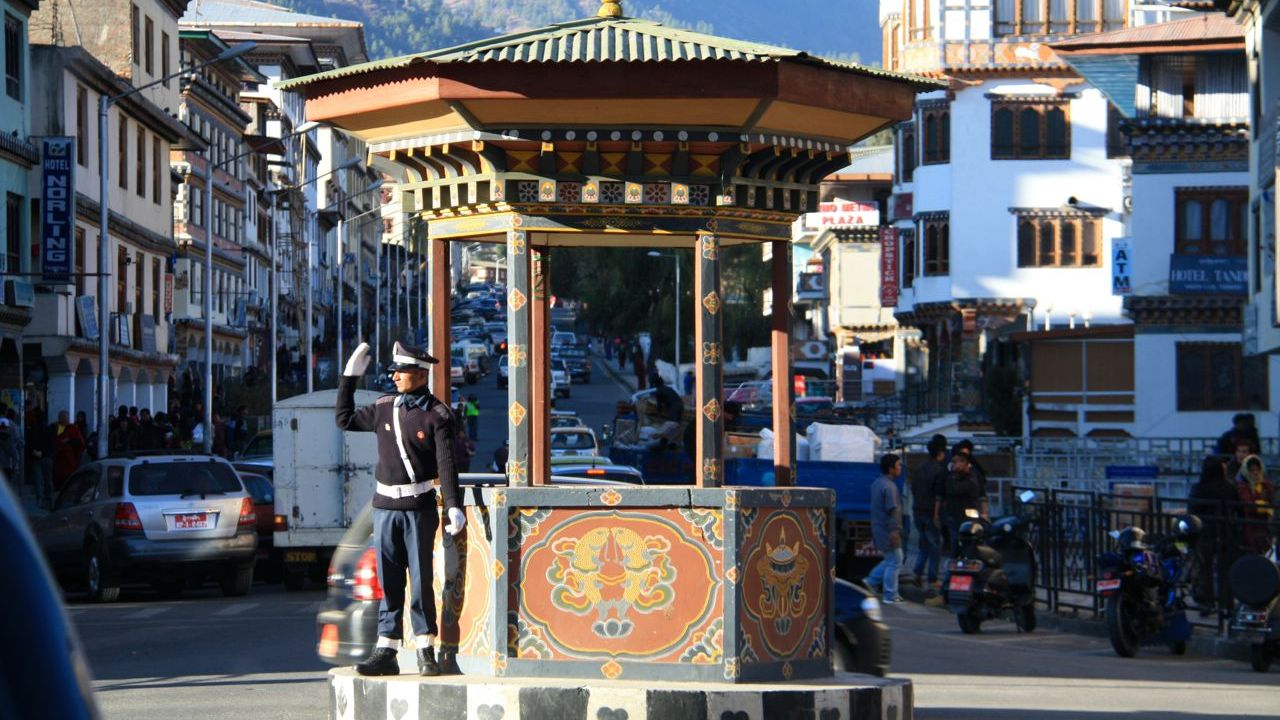
Thimphu, the capital city of Bhutan, distinguishes itself from capitals around the world by its unique absence of traffic lights. In a move that reflects the country's preference for simplicity and tradition, Thimphu relies on traffic police to direct vehicles at major intersections, rather than using electronic signals. This decision came after a brief trial with a single set of traffic lights, which was quickly removed following public disfavor. Residents felt that the impersonal nature of traffic lights did not suit the communal and human-centric ethos of Bhutanese society. The use of traffic police over traffic lights in Thimphu not only underscores Bhutan's commitment to maintaining its cultural values and human touch in everyday interactions but also adds to the charm and distinctiveness of this Himalayan city, making it a memorable aspect for visitors and a symbol of Bhutan's unique approach to modernization and technology.
Mandatory National Dress

In Bhutan, the mandatory national dress code is a distinctive aspect of its cultural identity, reflecting the country's deep-rooted traditions and national pride. Men wear the 'gho,' a knee-length robe tied at the waist by a belt called a 'kera,' while women dress in the 'kira,' an ankle-length dress accompanied by a light outer jacket known as a 'tego.' This dress code is not just for show but is a daily requirement for all Bhutanese citizens, especially when they are in public places, government offices, schools, and during official functions and ceremonies. The rule helps preserve and promote Bhutan's rich cultural heritage and fosters a strong sense of national unity and identity among its people. It's a vivid expression of Bhutan's commitment to maintaining and celebrating its cultural values in the face of globalization, serving as a constant reminder of the country's history, traditions, and values.
A Tobacco-Free Nation
Bhutan stands out as a pioneering tobacco-free nation, having implemented one of the world's strictest anti-tobacco laws. In 2004, Bhutan made a historic move by banning the sale and smoking of tobacco products across the kingdom. This bold legislative action was driven by concerns over public health and the negative impacts of tobacco use. The law reflects Bhutan's holistic approach to well-being, consistent with its philosophy of Gross National Happiness. Offenses related to tobacco sales and consumption can lead to significant fines and penalties, underlining the seriousness with which Bhutan approaches public health and environmental preservation. This ban also extends to the cultural realm, where tobacco use is discouraged in both public and private spaces, reinforcing the nation's commitment to the health and happiness of its people. Bhutan's tobacco ban is a testament to its proactive and protective stance on health and wellness, setting a global example for public health policy.
Land of The Unclimbed Peaks
Bhutan, often referred to as the Land of the Thunder Dragon, holds a unique distinction in the world of mountaineering and exploration as the land of the unclimbed peaks. Home to some of the highest and most majestic mountains in the Eastern Himalayas, Bhutan has made a conscious decision to prohibit climbing mountains higher than 6,000 meters out of respect for local spiritual beliefs that consider these peaks as the sacred abodes of protective deities. This policy reflects Bhutan's deep-rooted reverence for nature and its commitment to preserving the pristine beauty and ecological balance of its mountainous landscapes. Unlike the neighboring regions of Nepal and Tibet, where peak climbing is a major attraction, Bhutan's unclimbed mountains remain untouched by human ambition, embodying the country's unique blend of environmental conservation and spiritual values. This stance not only protects the environment but also upholds the cultural and spiritual sanctity of these natural wonders, making Bhutan a fascinating case of harmony between humanity and nature.
Phallus Paintings for Protection
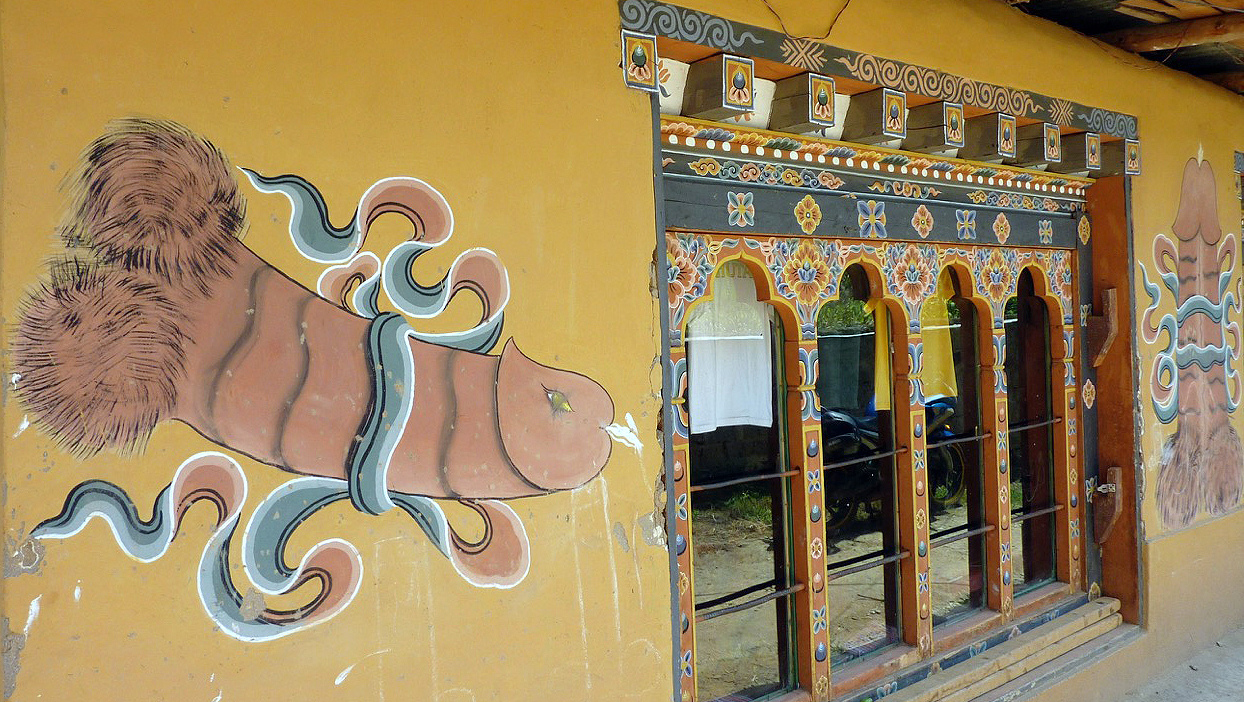
In Bhutan, the tradition of painting phalluses on the walls of houses and hanging wooden phalluses from the eaves is a distinctive cultural practice deeply rooted in local folklore and religion. This unique custom is believed to ward off evil spirits and promote fertility, originating from the teachings of Lama Drukpa Kunley, a 15th-century Buddhist monk affectionately known as the "Divine Madman" for his unconventional and humorous methods of spreading enlightenment. Lama Drukpa Kunley is revered for his teachings that upended societal norms and challenged the rigidity of the establishment, using shock and humor to open the minds of the people. The phallus paintings and carvings, often seen in the villages of Bhutan, especially in the Punakha region, serve not only as symbols of protection and good luck but also as reminders of the importance of embracing natural human desires and the impermanence of life. This practice showcases Bhutan's rich cultural tapestry, where spirituality and everyday life intertwine seamlessly, and where ancient traditions continue to influence modern beliefs and practices.
National Sport: Archery
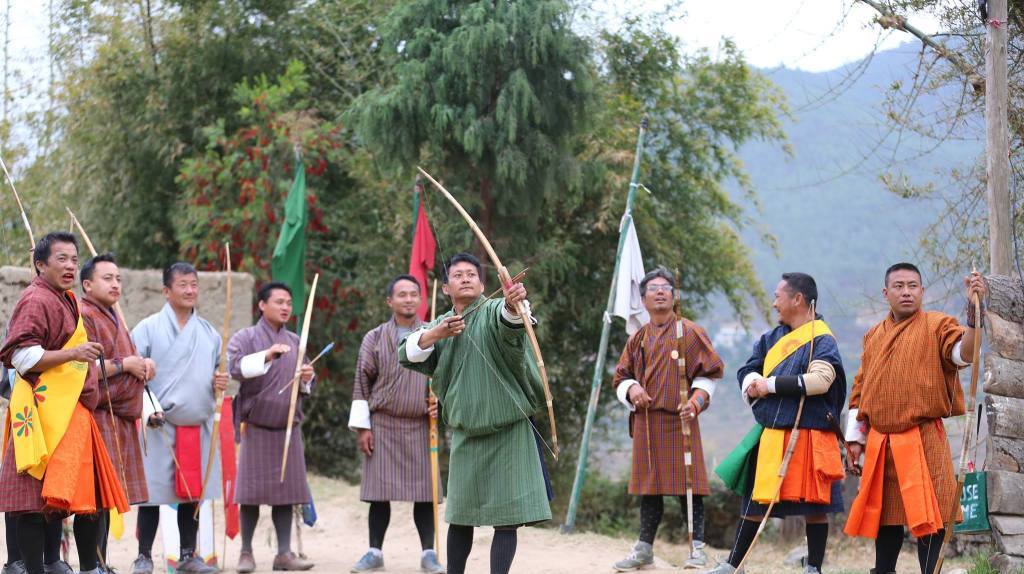
Archery holds the esteemed position of the national sport in Bhutan, deeply ingrained in the country's culture and social life. This traditional sport transcends mere competition, embodying Bhutan's historical significance, communal values, and spiritual symbolism. Archery competitions are vibrant communal events, often accompanied by music, dance, and a spirited display of camaraderie and rivalry. Participants, dressed in traditional attire, use bamboo bows and arrows, adhering to centuries-old techniques and rituals. These events are not just about hitting the target but also about celebrating Bhutanese heritage, fostering social bonds, and invoking protective deities through ritual and song. The sport is taken very seriously, with archery ranges found in every village and competitions organized during various festivals and public holidays. It's a spectacle that brings together communities, reinforcing national identity and providing a lively and colorful insight into Bhutanese culture and tradition.
The Takin: A Unique National Animal

The Takin, Bhutan's national animal, is a unique and somewhat mysterious creature that embodies the mystical essence of this Himalayan kingdom. With its peculiar appearance that seems to combine features of a cow and a goat, the Takin is more than just an oddity of nature; it represents Bhutan's rich biodiversity and its commitment to conservation. According to local legend, the Takin was created by the revered 15th-century saint, Lama Drukpa Kunley, from the bones of a cow and a goat as a demonstration of his divine powers. This animal, found primarily in the high-altitude regions of Bhutan, is not only a symbol of the country's unique natural heritage but also a living reminder of Bhutanese myths and legends. The Takin's significance goes beyond its status as a national symbol; it plays a crucial role in Bhutan's ecological and cultural identity, reflecting the nation's deep spiritual connection with its natural environment.
Only One Intertnational Airport
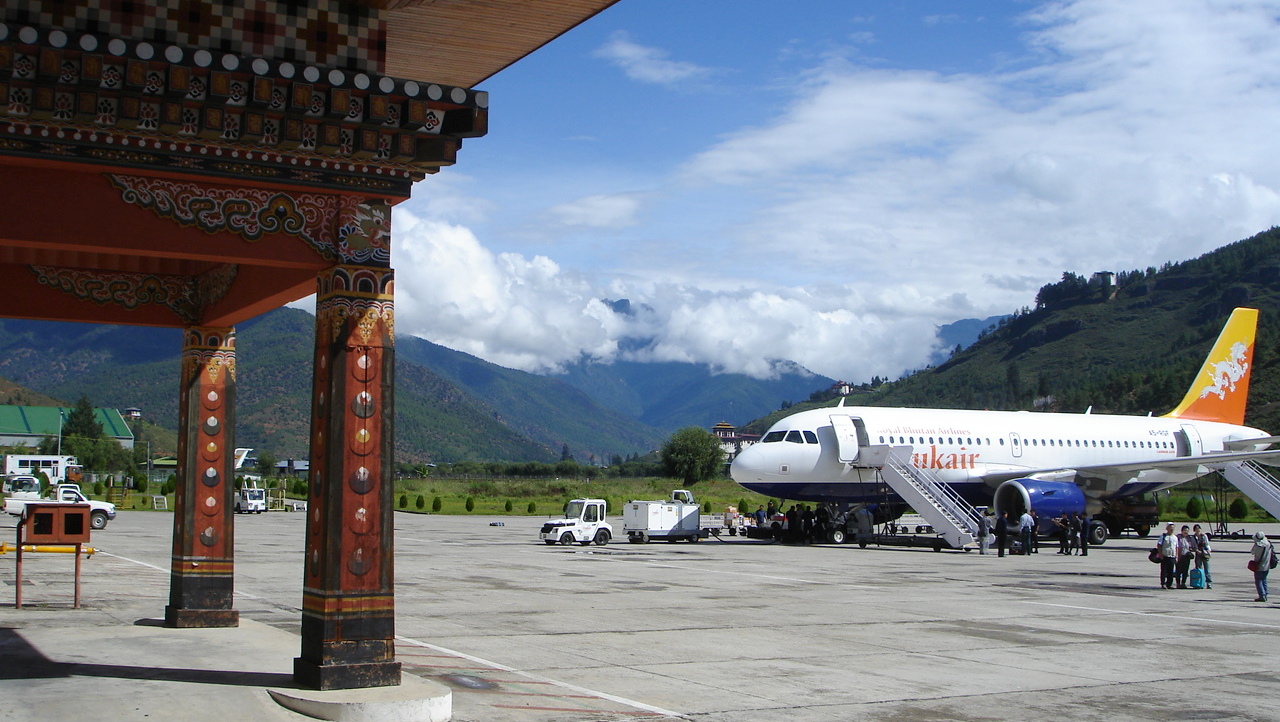
Bhutan, nestled in the heart of the Himalayas, boasts a single international airport, Paro International Airport, serving as the gateway to this mystical kingdom. Situated in the picturesque Paro Valley, surrounded by towering mountains, the airport offers breathtaking views during takeoff and landing. Despite its relatively small size and challenging terrain, Paro International Airport is renowned for its skilled pilots who navigate through narrow valleys and unpredictable weather conditions to ensure safe arrivals and departures. This airport serves as the primary point of entry for travelers seeking to explore Bhutan's rich cultural heritage, pristine landscapes, and vibrant traditions, providing a memorable introduction to this enchanting kingdom.
A Haven of Biodiversity
Bhutan, nestled in the heart of the Eastern Himalayas, is a veritable haven of biodiversity, boasting an environment that ranges from subtropical plains to steep mountains and valleys. This diverse topography supports a remarkable variety of flora and fauna, some of which are endemic to the region. Over 70% of Bhutan's land area is forested, a testament to the country's commitment to conservation and environmental protection, mandated by its constitution to remain at least 60% forested in perpetuity. Bhutan's protected areas, which include national parks, wildlife sanctuaries, and nature reserves, cover more than half of the country, interconnected by biological corridors that allow wildlife to move freely and maintain genetic diversity. This network of protected areas is home to rare and endangered species such as the Bengal tiger, snow leopard, red panda, and the Bhutan takin, the country's national animal. Bhutan's approach to biodiversity conservation is holistic, integrating traditional Buddhist values with modern conservation efforts, and serves as a model for sustainable development and environmental stewardship worldwide. The kingdom's rich natural heritage and its successful conservation policies underscore Bhutan's role as a guardian of biodiversity for the global community.
The Monastic Life
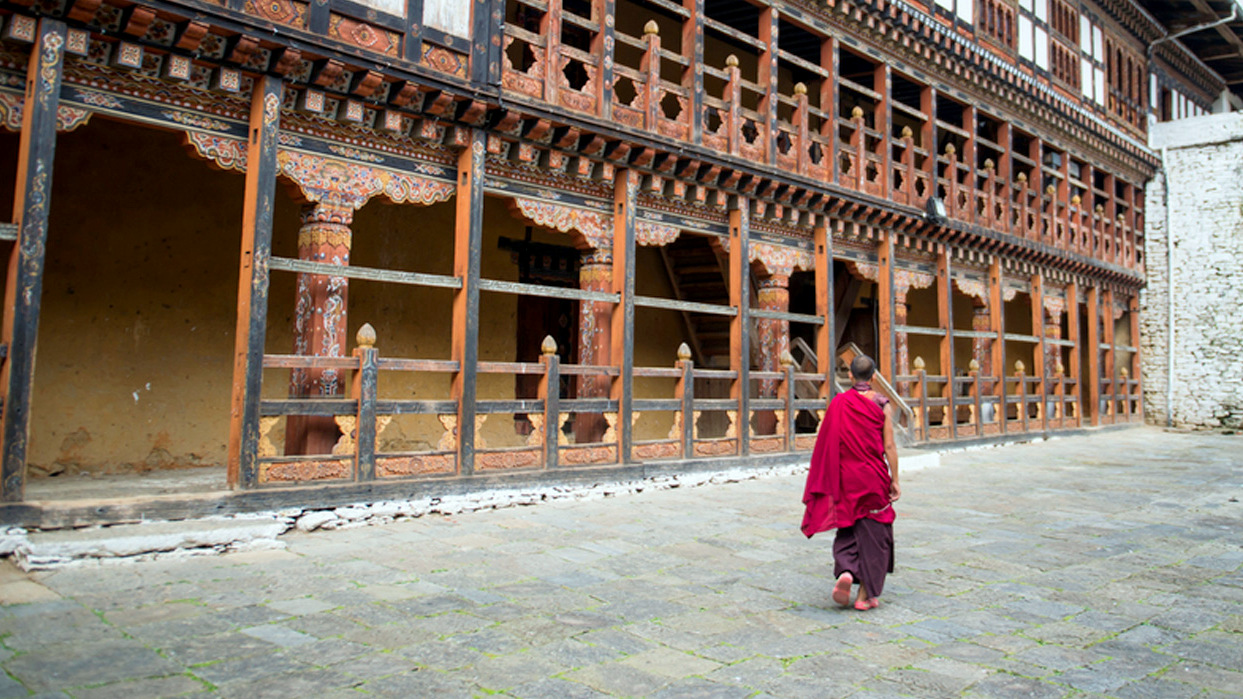
The monastic life is a cornerstone of Bhutanese society, deeply intertwined with the country's cultural and spiritual fabric. Bhutan, a Buddhist kingdom, places great emphasis on the teachings of Buddhism, which permeate every aspect of daily life and governance. Many Bhutanese men, at some point in their lives, choose to live as monks, residing in monasteries that dot the landscape from remote mountainsides to urban centers. These monastic institutions serve not only as places of worship and spiritual learning but also as community centers where people gather for religious ceremonies, festivals, and educational purposes. The monastic life in Bhutan is characterized by a disciplined routine of prayer, meditation, and study, aimed at achieving spiritual enlightenment and serving the community. This tradition reflects Bhutan's commitment to preserving its religious heritage, promoting peace, and fostering a sense of unity and purpose among its citizens, making the monastic life an integral part of the nation's identity and ethos.
Vibrant Festivals: Tshechus

Tshechus are vibrant festivals held annually in various temples, monasteries, and dzongs across Bhutan, serving as a deep expression of Bhutanese culture and Buddhist traditions. These colorful events are characterized by their elaborate masked dances, known as Cham dances, which tell stories of ancient myths, moral lessons, and religious history through intricate movements and symbolic gestures. Attended by families dressed in their finest traditional attire, Tshechus are not just religious ceremonies but also social gatherings that bring communities together, fostering a sense of unity and belonging. The festivals culminate in the unveiling of a giant thangka, a sacred religious painting, which is believed to bestow blessings upon all who behold it. Tshechus are a key aspect of Bhutanese life, encapsulating the country's spiritual depth, artistic heritage, and communal spirit, while serving as an important means of passing down traditions and teachings from one generation to the next.
Fortresses That Serve as Monastic Centers
In Bhutan, Dzongs serve a dual purpose as majestic fortresses and spiritual monastic centers, embodying the harmonious blend of the country's religious and administrative functions. These architectural marvels, strategically located throughout Bhutan, are characterized by their massive walls, beautifully intricate woodwork, and large courtyards that host various cultural and religious events, including the vibrant Tshechus festivals. Each Dzong houses a monastery and government offices, symbolizing the integration of spiritual and secular life in Bhutanese culture. Built in distinctive traditional Bhutanese architectural styles without the use of nails, these structures are not only centers of governance and religion but also serve as important cultural and historical symbols. The Dzongs play a crucial role in the community, providing a place for worship, meditation, and administration, and stand as a testament to Bhutan's unique approach to maintaining its cultural heritage and identity in the face of modernization.
Traditional Bhutanese Architecture
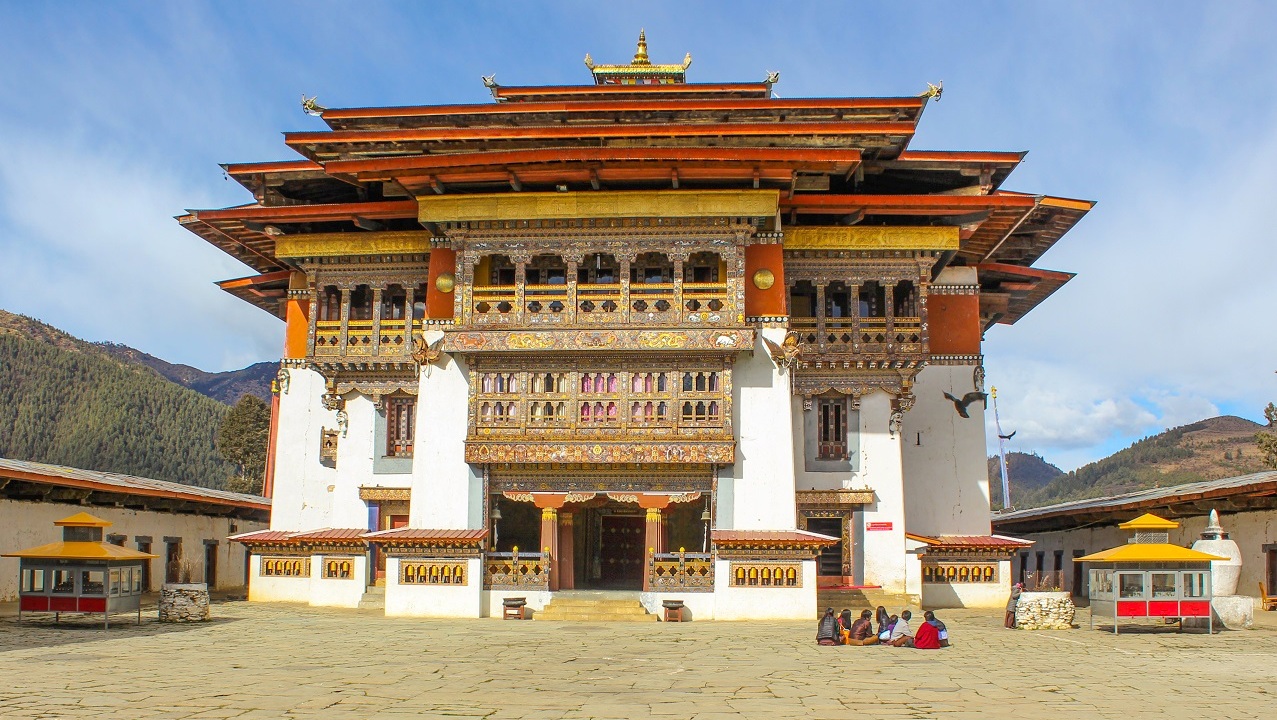
Traditional Bhutanese architecture is a distinctive and integral aspect of the country's cultural heritage, characterized by its harmonious blend with the natural landscape, use of locally sourced materials, and intricate decorative motifs. This architectural style is evident in the construction of dzongs, monasteries, temples, and traditional homes, which are built without the use of nails and are known for their sturdy stone foundations, whitewashed walls, and richly carved wooden windows and doors. The roofs are typically sloped and adorned with colorful flags and pennants, symbolizing various aspects of Buddhist philosophy. One of the most notable features is the multi-colored woodwork and the elaborate wall paintings that depict religious stories and important symbols of Bhutanese culture. These structures not only reflect the aesthetic values of Bhutanese society but also its deep-rooted spiritual beliefs, showcasing an extraordinary commitment to preserving tradition while harmonizing with the environment. Traditional Bhutanese architecture, therefore, represents a living art form, embodying the spiritual, cultural, and environmental consciousness of the Bhutanese people.
The Birth of Bhutanese Democracy
The birth of Bhutanese democracy marks a significant milestone in the country's history, transitioning from an absolute monarchy to a constitutional monarchy with a parliamentary democracy in 2008. This historic transformation was initiated by King Jigme Singye Wangchuck, who, in a visionary move, voluntarily began to cede his powers in favor of establishing a democratic system of governance. The process culminated in the drafting of Bhutan's first Constitution, which was ratified in 2008, laying down the framework for democratic governance, the rule of law, and the protection of human rights and freedoms. The first democratic elections were held the same year, allowing the Bhutanese people to vote for their representatives in the National Assembly. This transition was unique in that it was promoted by the monarchy itself, reflecting a deep commitment to the welfare and happiness of the Bhutanese people. The establishment of democracy in Bhutan was aimed at ensuring good governance and sustainable development, while still preserving the country's rich cultural heritage and traditions. The smooth transition to democracy, without the unrest or conflict seen in other parts of the world, underscores Bhutan's unique approach to change and progress.
Sustainable Tourism Through a High Daily Fee
Bhutan has adopted an innovative approach to sustainable tourism, characterized by its high daily fee for tourists, which is part of the country's broader strategy to manage visitor numbers and minimize environmental impact. This policy, known as the "High Value, Low Volume" tourism model, aims to promote responsible travel and ensure that tourism contributes positively to the country's economy, environment, and the preservation of its culture. The daily fee covers a comprehensive package that includes accommodation, transportation, a licensed Bhutanese tour guide, and a sustainable development fee that goes directly towards funding free education, healthcare, and environmental conservation projects in Bhutan. This approach not only helps in maintaining the exclusivity and pristine condition of Bhutan's natural and cultural heritage but also aligns with the country's philosophy of Gross National Happiness, by balancing economic development with environmental sustainability and cultural preservation. Through this model, Bhutan has set a global benchmark for sustainable tourism, ensuring that its tourism sector supports the country's development goals while safeguarding its unique identity and natural resources for future generations.
The Majestic Tiger’s Nest Monastery
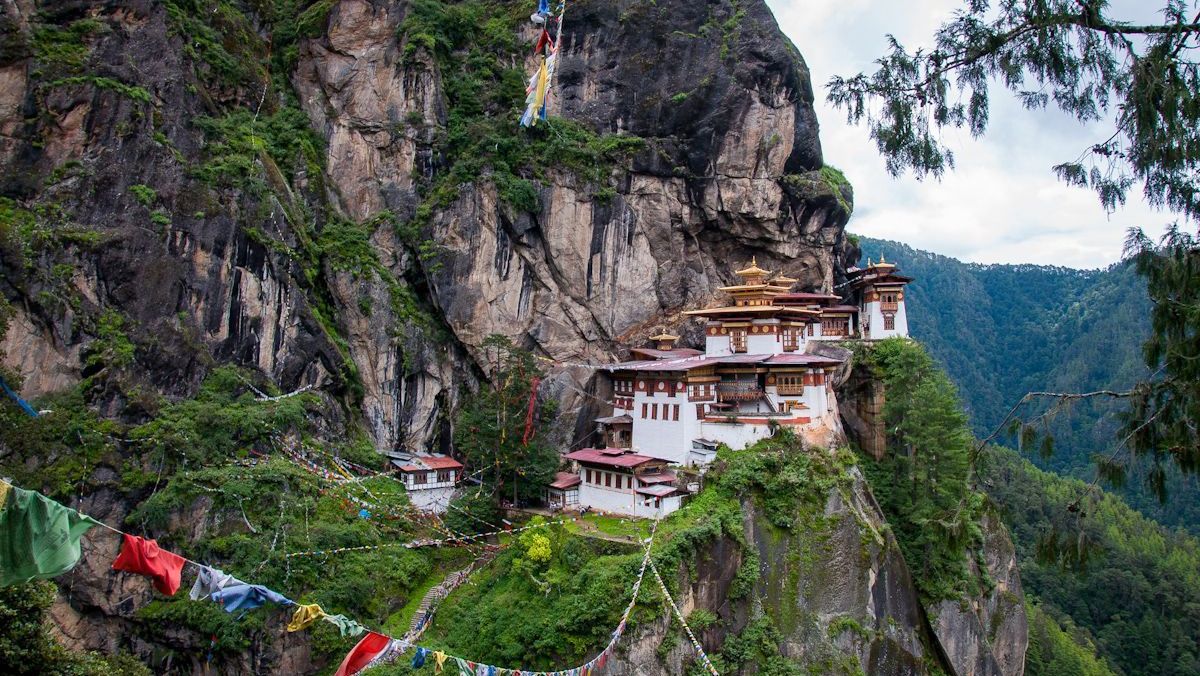
The Tiger's Nest Monastery, or Paro Taktsang, is one of Bhutan's most revered and breathtaking landmarks, perched precariously on the side of a cliff 900 meters above the Paro Valley. According to legend, Guru Rinpoche, also known as Padmasambhava, flew to this location from Tibet on the back of a tigress to subdue a local demon. He then meditated in a cave for three months, and it is around this cave that the Tiger's Nest Monastery was built in 1692. The site has been a place of pilgrimage for centuries and is considered one of the holiest places in Bhutan. Accessible only by foot or on horseback, the journey to the monastery is a spiritual rite of passage for visitors, offering not just awe-inspiring views but also a profound sense of peace and introspection. The architecture of the monastery seamlessly blends with the natural landscape, embodying Bhutanese tradition's deep respect for nature. The Tiger's Nest Monastery remains a symbol of human endeavor, religious devotion, and the extraordinary beauty of Bhutan's natural landscape.
Towards 100% Organic Farming
-0.jpg)
Bhutan is on a visionary quest to become the world's first 100% organic nation, a bold step towards sustainable agriculture and environmental conservation. Announced as a national goal, this initiative seeks to ban the use of all chemical pesticides and fertilizers, transitioning instead to natural methods that enhance soil fertility and protect biodiversity. This commitment to organic farming reflects Bhutan's broader philosophy of living in harmony with nature, rooted in the belief that sustainable practices are essential for the well-being of its people and the planet. By promoting organic agriculture, Bhutan aims to safeguard its pristine environment, ensure the health of its population, and preserve its agricultural heritage. The move towards complete organic farming also aligns with the country's Gross National Happiness framework, emphasizing sustainable development, conservation of the natural environment, and preservation of cultural values. Bhutan's journey towards 100% organic farming is not only an ambitious endeavor but also a model for the world in sustainable and mindful living.
A Blossoming Literary Scene
Bhutan's literary scene is experiencing a renaissance, blossoming with a newfound vigor that mirrors the country's rich oral traditions and cultural heritage. This resurgence is marked by an increasing number of Bhutanese authors and poets who are finding their voices in both Dzongkha, the national language, and English, offering insights into the nation's soul through their narratives. The contemporary literary movement in Bhutan is a blend of ancient Buddhist texts, folklore, and modern themes, reflecting the country's journey through modernization while staying rooted in tradition. Literary festivals, workshops, and book fairs are becoming more prevalent, fostering a vibrant community of readers and writers passionate about literature's role in reflecting and shaping Bhutanese identity. This burgeoning interest in literature is not only enhancing Bhutan's cultural richness but also bridging gaps between generations and communities, showcasing the universal power of storytelling. Through this literary awakening, Bhutan is carving out a unique space for itself on the global literary map, demonstrating the profound depth and diversity of Bhutanese thought, spirituality, and artistic expression.
As we conclude our exploration of the "20 Fun Facts About Bhutan" with Amen Bhutan Tours and Treks, it's clear that Bhutan offers far more than just a travel destination; it presents a unique journey into a world where tradition, nature, and happiness converge. Through its commitment to preserving the environment, embracing sustainable practices, and upholding cultural values, Bhutan stands as a beacon of inspiration, teaching us the importance of living in harmony with our surroundings and each other. Whether you're marveling at the majestic Tiger’s Nest Monastery, participating in the communal joy of a Tshechu festival, or simply soaking in the profound peace that pervades this land, a trip to Bhutan with Amen Bhutan Tours and Treks is an opportunity to experience the essence of Gross National Happiness. We invite you to join us on this transformative journey, where each step is a discovery of Bhutan's treasures and a step towards understanding the true meaning of contentment and sustainability.
If you are looking for tour packages in Bhutan please click here
If you need any further information, please contact us, Email: at [email protected] , Phone (Whatsapp or Viber) +975-1755-6636
